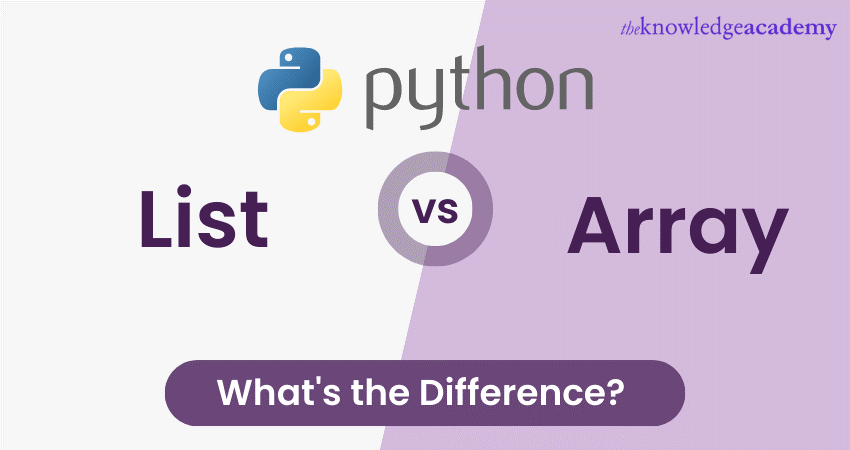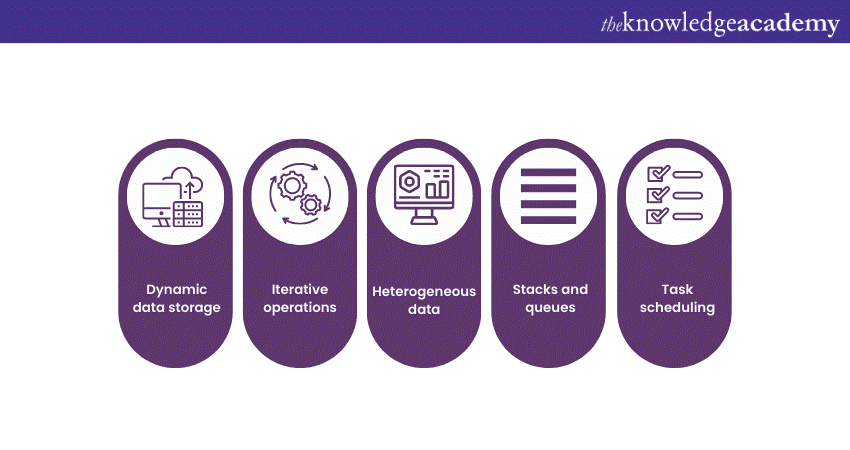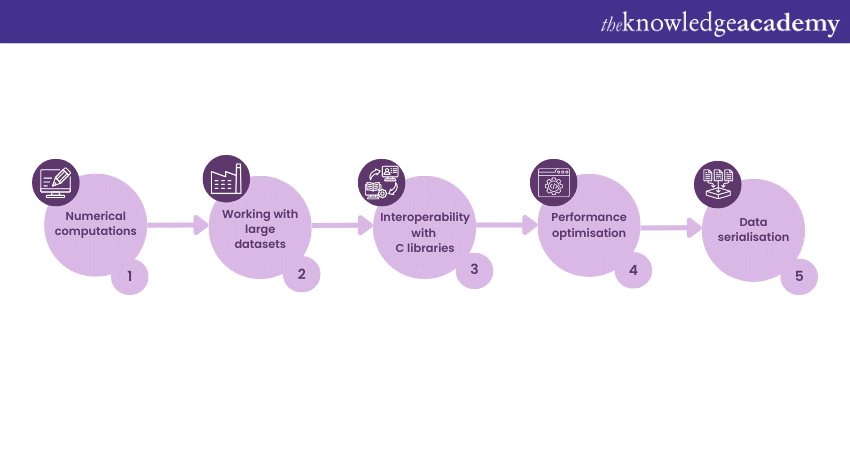We may not have the course you’re looking for. If you enquire or give us a call on 01344203999 and speak to our training experts, we may still be able to help with your training requirements.
Training Outcomes Within Your Budget!
We ensure quality, budget-alignment, and timely delivery by our expert instructors.

Python Lists and Arrays are fundamental data structures with distinctive features and serve vital roles in data handling and manipulation. More importantly, they can significantly affect performance and memory management in multiple scenarios.
According to JetBrains 2022 State of Developer Ecosystem report, Python is among the top five languages chosen by developers interested to adopt a new language. It is also one of the top three languages utilised the most by developers in 2022.
Now that these statistics have demonstrated Python’s demand and value in the development domain let us delve deeper into the functionalities of Python, namely the List and Array. Lists and arrays are the data structures used in Python to store multiple elements. This blog illustrates the Difference Between Python List vs Array. Read on to learn the key differences between them.
Table of Contents
1) An overview of a Python List
2) An overview of a Python Array
3) Exploring the Difference Between Python List vs Python Array
4) Looking at the use cases for a Python List
5) Looking at the use cases for a Python Array
6) Conclusion
An overview of a Python List
A Python List is a versatile and dynamic data structure in the Python programming language. It serves as an ordered collection that can hold various data types, including integers, strings, and other lists. Typically denoted by square brackets [], lists allow for easy addition, removal, and modification of elements, making them mutable.
Additionally, this flexibility enables developers to create and manipulate lists efficiently. With its ability to handle heterogeneous data and support iterative operations, a Python list proves to be a fundamental tool for data storage, processing, and manipulation, making it a popular choice among programmers for its simplicity and practicality.
An overview of a Python Array
A Python array is a specialised data structure in the Python programming language designed for the efficient handling of homogeneous data, particularly numeric values. Arrays are fixed in size and require elements of the same data type, leading to improved memory allocation and computational performance.
Additionally, by importing the array module, developers can create arrays to store and process large datasets with ease. Due to their immutability, arrays ensure data integrity and are particularly suitable for numerical computations and operations that demand consistent data types. Python arrays are a powerful tool for optimising performance and memory utilisation in scenarios involving uniform data.
Exploring the Difference Between Python List vs Python Array
Here are the differences highlighted between the Python List and Array:
|
Feature |
Python List |
Python Array |
|
Data types |
Lists can hold various data types, including mixed types |
Arrays require elements of the same data type |
|
Mutability |
Lists are mutable, allowing for easy element modification |
Arrays are immutable in size but allow individual element modification |
|
Memory allocation |
Lists have higher memory overhead due to dynamic resizing |
Arrays offer more efficient memory allocation for uniform data |
|
Functionality |
Lists provide a wide range of built-in functions and methods |
Arrays offer limited methods, mainly focused on numerical computations |
|
Performance |
Lists are generally slower in numerical computations |
Arrays outperform lists in scenarios involving numerical operations |
|
Use cases |
Ideal for dynamic data storage and manipulation |
Best suited for numeric computations and large datasets |
|
Ease of use |
Lists are simple to use and versatile |
Arrays may require more consideration for data uniformity |
|
Creation syntax |
Example: my_list = [1, "hello", 3.14] |
Example: my_array = array('i', [1, 2, 3, 4, 5]) |
|
Memory efficiency |
Lists may consume more memory due to mixed data types |
Arrays provide better memory efficiency for homogeneous data |
|
Iterative operations |
Lists are suitable for tasks requiring frequent changes |
Arrays are efficient for vectorised operations and computations |
|
Interoperability |
Lists offer better compatibility with other data structures |
Arrays ensure seamless interoperability with C libraries and low-level code |
|
Size flexibility |
Lists can dynamically resize based on elements added or removed |
Lists can dynamically resize based on elements added or removed |
|
Speed of operations |
Lists may be slower in certain numerical operations Lists may be slower in certain numerical operations |
Arrays exhibit faster performance in numeric computations |
|
Example use case |
Keeping a record of user data with varying attributes |
Performing complex mathematical calculations with large datasets |
Learn to develop and maintain Python scripts, by signing up for the Python Programming Course now!
Looking at the use cases for a Python List
Python lists are incredibly versatile data structures, and their dynamic nature makes them suitable for various use cases in programming. Here are some common scenarios where Python lists prove to be valuable tools:

a) Dynamic data storage: One of the primary use cases for Python lists is to store data that can change in size or structure. Lists can be easily expanded or contracted, allowing developers to handle varying amounts of information efficiently. Whether it's a collection of user inputs, sensor readings, or log entries, lists provide the flexibility to accommodate dynamic data requirements.
b) Iterative operations: Lists are excellent for tasks that involve frequent iteration and manipulation of elements. Using loops, you can easily access each element of the list, perform specific operations, or modify the data as needed. This makes lists a preferred choice for implementing algorithms that require repetitive tasks, such as searching, sorting, or filtering.
c) Heterogeneous data: Python lists can hold elements of different data types within the same list. This flexibility is particularly useful when dealing with datasets containing diverse information. For instance, a list could contain integers, strings, and even nested lists, providing a convenient way to organise complex data structures.
d) Stacks and queues: Lists can be used to implement stack and queue data structures due to their ability to add and remove elements efficiently from either end. Stacks follow the Last-In-First-Out (LIFO) principle, while queues adhere to the First-In-First-Out (FIFO) principle, making lists a natural fit for managing data in these scenarios.
e) Task scheduling: In applications where tasks need to be executed in a specific order, lists can act as task queues. Users can add more tasks to the list, and as they are completed or processed, they can be removed or marked as completed. This mechanism simplifies task scheduling and ensures a systematic execution flow.
f) Data filtering and selection: Lists facilitate data filtering based on specific criteria. For example, you can use list comprehensions or built-in filter functions to create new lists containing elements that meet certain conditions, making it easier to extract relevant data from larger datasets.
g) Multiple return values: Python lists allow functions to return multiple values by packing them into a single list. This is particularly helpful when a function needs to return several related pieces of information as a group. The calling code can then easily unpack the returned list and access the individual values.
h) Data conversion: Lists can be instrumental in converting data from one format to another. For instance, you can convert a string into a list of characters or break down a sentence into individual words, enabling further processing and analysis.
i) User input management: In interactive applications, lists can be utilised to manage user inputs. As users provide information through forms or prompts, the inputs can be stored in a list, making it convenient to validate, process, or display the collected data.
j) Data analysis and visualisation: When working with data analysis or visualisation libraries, such as NumPy or Matplotlib, Python lists are often the starting point for storing data before feeding it into these libraries. Lists offer a simple and compatible way to manage data before conducting complex calculations or generating graphical representations.
Learn to analyse and visualise data, by signing up for the Data Analysis and Visualisation with Python Course now!
Looking at the use cases for a Python Array

Python arrays are specialised data structures designed for specific use cases, especially when dealing with homogeneous data, primarily numeric values. Here are several scenarios where Python arrays excel and prove to be valuable tools:
a) Numerical computations: Python arrays are ideal for performing mathematical operations on large sets of numeric data. Due to their fixed size and uniform data type, arrays facilitate vectorised operations, allowing for faster and more efficient computations. Tasks such as matrix operations, statistical calculations, and mathematical simulations benefit significantly from the performance gains offered by arrays.
b) Working with large datasets: When dealing with massive datasets containing uniform data, Python arrays are memory-efficient choices. Unlike lists, arrays allocate contiguous memory locations, reducing memory overhead and enabling more efficient memory utilisation, making them a preferred option when working with big data.
c) Interoperability with C libraries: Python arrays can seamlessly interface with C libraries and low-level code. This characteristic is advantageous when developers need to access performance-critical functionality or utilise specialised numerical libraries. The ability to pass array data directly to C functions without the need for data conversion enhances both performance and code readability.
d) Performance optimisation: In situations where performance is critical, such as scientific simulations or computational-heavy applications, Python arrays offer a significant advantage over lists. Their memory-efficient design and optimised numerical operations lead to faster execution times and more responsive applications.
e) Data serialisation: Python arrays are useful for data serialisation, where data needs to be stored or transmitted in a compact and standardised format. By converting data into arrays, developers can ensure that the receiving end can easily interpret and process the information.
f) Image and signal processing: In image and signal processing tasks, arrays are commonly used to store pixel values or signal samples. Due to their numeric nature, arrays facilitate the manipulation and analysis of such data, enabling tasks like filtering, transformation, and feature extraction.
g) Numerical simulations: When simulating complex systems or models that involve numerous iterations and calculations, Python arrays provide the computational power needed to handle vast amounts of numerical data efficiently. Whether it's simulating physical processes or modelling financial scenarios, arrays play a crucial role in such simulations.
h) Scientific data analysis: Scientists often rely on Python arrays to process and analyse experimental data. The numeric precision and performance benefits offered by arrays make them a preferred choice for scientific computing, ensuring accurate results in research and analysis.
i) Time series data: Time series data, which consists of data points indexed by time, can be efficiently stored and processed using Python arrays. The predictable and uniform structure of arrays simplifies data alignment and time-based computations.
j) Machine learning applications: In machine learning, arrays are widely used to store and manipulate training data and model parameters. The computational efficiency of arrays is vital in training complex models and handling vast datasets, making them a fundamental data structure in the field of artificial intelligence.
Conclusion
Both Python Lists and Arrays serve distinct purposes and offer valuable contributions to the programming landscape. Python lists provide flexibility and dynamic data storage, making them versatile for various tasks. On the other hand, Python arrays excel in handling homogeneous numeric data, delivering superior performance and memory efficiency. Understanding the strengths of each data structure empowers developers to choose the most suitable option based on specific use cases, optimising their programming experience and overall application performance.
Learn a range of programming courses as well as libraries and frameworks, by signing up for the Programming Training Courses now!
Frequently Asked Questions
Upcoming Programming & DevOps Resources Batches & Dates
Date
 Python Course
Python Course
Mon 20th Jan 2025
Mon 24th Mar 2025
Mon 26th May 2025
Mon 28th Jul 2025
Mon 22nd Sep 2025
Mon 17th Nov 2025







 Top Rated Course
Top Rated Course



 If you wish to make any changes to your course, please
If you wish to make any changes to your course, please


